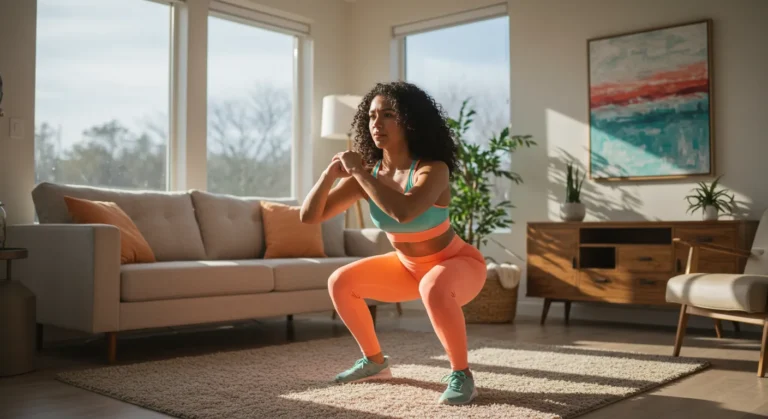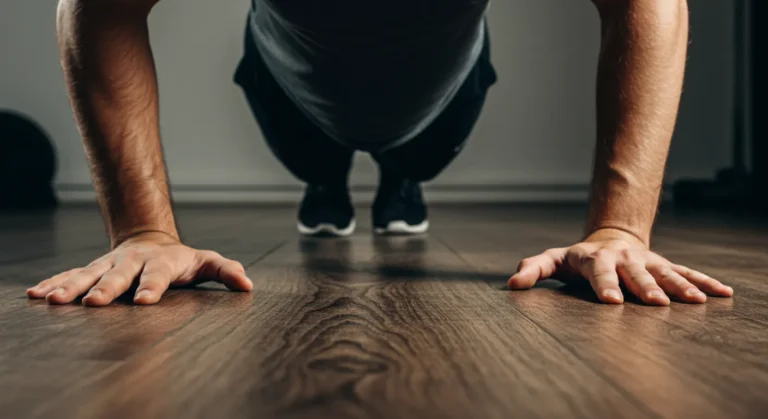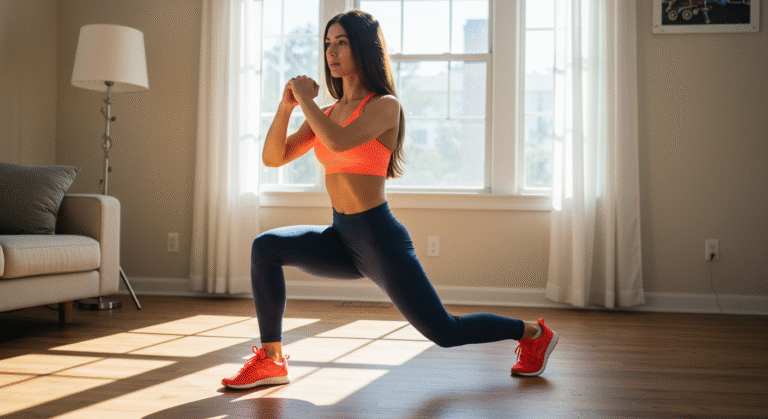Functional Exercises: How to Build Strength, Mobility, and Longevity

Picture this: you’re moving apartments, and while your gym-going friends are struggling to carry boxes up three flights of stairs, you’re effortlessly hauling furniture without breaking a sweat or throwing out your back. Or maybe you’re playing with your kids at the park, keeping up with their boundless energy while other parents watch from the sidelines, too tired or worried about injury to join in.
That’s the power of functional exercises – training that prepares your body for real life, not just looking good in the mirror.
Two years ago, Federico could bench press his body weight but couldn’t pick up a heavy suitcase without his lower back screaming for mercy. Giulia could run for miles on a treadmill but felt exhausted after a day of gardening. We were “fit” according to traditional standards, but completely unprepared for the physical demands of actual living.
Everything changed when we discovered functional strength training – a approach that builds strength, mobility, and resilience for the movements you do every single day. No more choosing between looking fit and feeling capable. No more workouts that leave you sore in all the wrong places.
Today, we want to share everything we’ve learned about building real-world strength through functional fitness workouts that work with your body, not against it. Whether you’re a complete beginner or someone looking to make your current routine more practical, this guide will show you how to train for the life you actually live.
What Is Functional Training and Why Everyone Needs It
Functional training isn’t just another fitness trend – it’s a return to how human bodies were designed to move. Instead of isolating individual muscles like traditional gym routines, functional exercises train movement patterns that mirror real-life activities.
Think about your daily movements: squatting down to pick something up, pushing open heavy doors, pulling yourself up from a low chair, twisting to reach for items, or carrying groceries while walking. These multi-joint, multi-muscle actions are exactly what functional exercises prepare you for.
The magic happens when your workouts start improving your actual life instead of just your gym performance.
The Difference Between Functional and Traditional Workouts
Traditional gym routines often focus on isolation exercises – bicep curls, leg extensions, chest flies. While these can build muscle, they don’t teach your muscles to work together as a coordinated system.
Functional strength training takes a different approach:
| Traditional Training | Functional Training |
| Isolates single muscles | Integrates multiple muscle groups |
| Fixed machine movements | Free-range motion patterns |
| Focuses on appearance | Emphasizes performance |
| Trains in single planes | Moves in all directions |
| Often seated or lying down | Emphasizes standing patterns |
When Giulia switched from traditional weight machines to functional training workouts, she noticed the difference immediately. Instead of feeling disconnected muscle soreness, she felt strong and coordinated. Her body started moving as one integrated unit rather than a collection of separate parts.
Everyday Movements That Define True Strength
Real strength isn’t measured by how much you can lift in perfect conditions – it’s about how well you can handle the unpredictable physical demands of life.
The Seven Fundamental Movement Patterns:
- Squat – Sitting down, standing up, picking things off the floor
- Hinge – Bending at hips to lift objects, tying shoes
- Push – Opening doors, pushing strollers, getting up from the ground
- Pull – Lifting heavy objects, opening tight jars, climbing
- Carry – Moving groceries, luggage, children
- Rotate – Looking over your shoulder, reaching across your body
- Gait – Walking, running, climbing stairs
Federico’s “aha moment” came when he realized his gym routine included none of these patterns. He was strong in artificial positions but weak in the movements he needed most. Once he started training these fundamental patterns, everyday tasks became effortless instead of challenging.
Benefits Beyond Fitness: Longevity, Mobility, and Confidence
The real magic of functional exercises goes far beyond looking good or even feeling strong. It’s about maintaining independence, preventing injury, and aging with grace and capability.
Training for Real Life, Not Just Aesthetics
Injury Prevention Through Movement Quality
Most injuries happen during normal activities – lifting something awkwardly, slipping on wet floors, or simply moving in ways your body isn’t prepared for. Functional strength training creates resilience by teaching your body to handle unexpected movements safely.
After six months of consistent functional exercises, Federico noticed he could work in the garden for hours without the usual next-day stiffness. Giulia found herself naturally moving with better posture and confidence, even when tired or distracted.
Enhanced Daily Performance
The benefits of exercise extend into every aspect of your day:
- Climbing stairs without getting winded
- Carrying groceries in one trip without strain
- Playing with children without fear of injury
- Maintaining energy throughout long workdays
- Sleeping better due to improved movement quality and reduced tension
Cognitive and Emotional Benefits
Functional training workouts engage your brain as much as your body. Coordinating complex movements improves neural pathways, enhances balance, and builds the kind of confidence that comes from feeling capable in your own skin.
Functional Exercise: Why This Works for Any Age or Body Type
One of the most beautiful aspects of functional training is its adaptability. Unlike traditional gym routines that often require specific equipment or fitness levels, functional exercises can be modified for anyone.
For Beginners:
- Start with bodyweight versions of each movement
- Focus on form and control over speed or intensity
- Build gradually as movement quality improves
For Active Individuals:
- Add resistance and complexity to familiar patterns
- Combine movements for greater challenge
- Focus on weakness areas identified through daily activities
For Older Adults:
- Emphasize balance and stability components
- Use supported versions of movements
- Prioritize mobility and coordination over intensity
For Those with Limitations:
- Adapt movements to work around injuries or restrictions
- Use chairs, walls, or bands to modify exercises
- Focus on maintaining and improving current function
Giulia’s 65-year-old mother started functional training after struggling with balance issues. Within three months, she was confidently navigating uneven terrain and hadn’t had a fall since starting the program.
If you want to dive even deeper into how strength and conditioning works, check out resources from the National Strength and Conditioning Association (NSCA) – they’ve got tons of great info and research to back it up.
Tools and Techniques to Start Functional Strength Training
The beauty of functional fitness workouts is their simplicity. You don’t need a gym membership or expensive equipment to build real-world strength. Your body is the most sophisticated training tool ever created.
Bodyweight, Kettlebell, and Resistance Bands
Bodyweight Training: Your Always-Available Gym
Your body provides perfect resistance for building functional strength. Bodyweight exercises like squats, push-ups, and lunges can be endlessly modified to match your current ability and continue challenging you as you improve.
Essential Bodyweight Movement Progressions:
- Squat Progression: Chair-assisted → Bodyweight → Single-leg → Jump squat
- Push Progression: Wall push-up → Knee push-up → Full push-up → Decline push-up
- Pull Progression: Assisted pull-up → Negative pull-up → Full pull-up → Weighted pull-up
Kettlebells: Maximum Function in Minimum Space
If you’re going to invest in one piece of equipment, make it a kettlebell. This simple tool enables hundreds of functional exercises that build strength, power, and cardiovascular fitness simultaneously.
Federico’s entire morning workout routine at home centers around a single 35-pound kettlebell. In 20 minutes, he can work every major movement pattern while getting his heart rate up and breaking a good sweat.
Key Kettlebell Movements:
- Kettlebell Swing – Hip hinge power and cardiovascular conditioning
- Turkish Get-Up – Total-body coordination and stability
- Goblet Squat – Deep squatting pattern with core engagement
- Kettlebell Carry – Functional strength and postural endurance
Resistance Bands: Portable and Versatile
Resistance bands are perfect for travel, small spaces, or adding variety to bodyweight routines. They’re particularly excellent for mobility exercises and rehabilitation movements.
How to Design a Simple Weekly Routine
The key to sustainable functional training is consistency over complexity. A simple routine performed regularly will always outperform an elaborate program that’s too complicated to maintain.
The Weekly Template:
Monday & Thursday: Full-Body Strength
- Focus on major movement patterns
- 3-4 exercises, 3 sets each
- 30-45 minutes total
Tuesday & Friday: Mobility and Movement
- Hip mobility exercises and flexibility stretches
- Light movement to support recovery
- 20-30 minutes of gentle activity
Wednesday: Power and Conditioning
- HIIT workouts at home using functional movements
- Combine strength and cardiovascular training
- 20-30 minutes of higher intensity work
Weekend: Active Recovery
- Walking, hiking, recreational activities
- Focus on enjoyment and stress relief
- Listen to your body’s needs
Some weeks you’ll hit every session, others you might only manage two or three. Progress comes from consistency over time, not perfect adherence.
Our Story: From Overtraining to Training for Life
A few years ago, we embodied everything wrong with modern fitness culture. Our workouts were punishing affairs designed to “crush” us rather than build us up. We measured success by soreness levels and pushed through pain that should have been warning signals.
How We Integrated Functional Fitness Into Our Lives
The shift started when Federico threw out his back doing something as simple as picking up a dropped pen. Here he was, supposedly “fit” and strong, yet defeated by a basic life movement. That’s when we began questioning whether our training was actually preparing us for life or just for more training.
Our Functional Fitness Evolution:
Phase 1: Learning to Move Well We started with basic bodyweight movements, focusing on form over intensity. It was humbling to struggle with movements that seemed “too easy” compared to our previous workouts.
Phase 2: Adding Resistance Thoughtfully As our movement quality improved, we gradually added kettlebells and resistance bands. The focus remained on how exercises felt and whether they improved our daily function.
Phase 3: Integrating Play and Variety We started incorporating activities we actually enjoyed – hiking, dancing, playing sports with friends. Exercise became less about obligation and more about living fully.
Phase 4: Teaching What We Learned As we experienced the life-changing benefits of functional training, we felt compelled to share these discoveries with others struggling with the same fitness frustrations we’d experienced.
Why We Teach What We Live
We don’t recommend any exercise or approach we haven’t personally tested and refined. Every functional training workout we share comes from our own experience of what works sustainably in real life, not just what looks good in theory.
Our approach isn’t about creating fitness addicts or people dependent on complicated routines. We want to help you build a strong, capable body that serves your life goals rather than dominating your schedule.
The most rewarding part of our work is hearing from people who’ve rediscovered the joy of movement and the confidence that comes from feeling strong and capable in their own skin.
How to Start Functional Training
Starting functional strength training doesn’t require a complete lifestyle overhaul. The most sustainable approach is to begin with simple movements you can easily integrate into your existing routine.
First Moves to Learn
Week 1-2: Master the Fundamentals
Start with these four basic patterns, performing them every other day:
1. Bodyweight Squat (Lower Body Foundation)
- Stand with feet shoulder-width apart
- Lower down as if sitting in a chair
- Keep chest up, knees tracking over toes
- Start with 2 sets of 8-12 repetitions
2. Modified Push-Up (Upper Body Strength)
- Begin with wall push-ups or knee push-ups
- Focus on straight line from head to knees/feet
- Control both the lowering and pushing phases
- Start with 2 sets of 5-10 repetitions
3. Glute Bridge (Hip Strength and Activation)
- Lie on back, knees bent, feet flat on floor
- Squeeze glutes and lift hips toward ceiling
- Hold for 2 seconds at the top
- Start with 2 sets of 10-15 repetitions
4. Plank Hold (Core Stability)
- Hold a straight line from head to heels
- Begin with 15-30 second holds
- Focus on breathing naturally while maintaining position
- Work up to 1-minute holds
Week 3-4: Add Movement Complexity
Once the basics feel comfortable, introduce these progressions:
5. Step-Up (Single Leg Strength)
- Use a sturdy chair or step
- Step up with control, don’t push off back foot
- Step down slowly and controlled
- Alternate legs for 2 sets of 8 per side
6. Dead Bug (Core Coordination)
- Lie on back, arms reaching toward ceiling
- Knees bent at 90 degrees
- Lower opposite arm and leg slowly
- Return to start, switch sides
- 2 sets of 6 per side
Avoiding Common Mistakes While Building Strength
Mistake #1: Rushing Through Progressions
The biggest error we see is people advancing too quickly through exercise progressions. Your joints and connective tissues adapt more slowly than your muscles. Give your body time to build a solid foundation.
Federico’s Rule: “If you can’t perform 15 perfect repetitions of a movement, you’re not ready for the next progression.”
Mistake #2: Ignoring Pain Signals
Discomfort from challenging muscles is normal. Sharp pain, joint pain, or pain that persists after exercise is not. Functional exercises should make you feel better, not worse.
Mistake #3: Comparing Yourself to Others
Your functional fitness journey is unique to your body, history, and goals. Focus on your own progress and how exercise improves your daily life rather than comparing yourself to others.
Mistake #4: Neglecting Recovery
Daily exercise routines need to include adequate recovery time. Your body adapts and grows stronger during rest periods, not just during workouts.
Giulia’s Recovery Protocol:
- At least one complete rest day per week
- Mobility exercises on lighter training days
- 7-9 hours of sleep for optimal recovery
- Stress management through mindfulness or gentle activities
Functional Training: Resources, Routines, and Tools to Support You
Building a sustainable functional fitness program is easier when you have the right support and resources. We’ve tested countless products and programs to find what actually works in real-world conditions.
Gear We Actually Use
Essential Equipment (In Order of Priority):
1. Quality Exercise Mat A good mat makes floor exercises comfortable and provides stability for bodyweight movements. We recommend mats that are at least 6mm thick for joint protection.
2. Resistance Band Set Perfect for hip mobility exercises, rehabilitation work, and adding resistance to bodyweight movements. Look for sets with multiple resistance levels and door attachments.
3. Kettlebell (20-35 lbs for most people) The most versatile single piece of equipment for functional training workouts. Start with a weight that allows you to perform 15 perfect swings.
4. Suspension Trainer Excellent for bodyweight strength training at home and easily adjustable difficulty levels. Particularly useful for pulling movements if you don’t have a pull-up bar.
Apps and Digital Resources:
Movement and Mobility Apps:
- Mobility exercises apps with guided routines
- Video libraries for proper form demonstration
- Progress tracking for consistency
HIIT and Functional Training Apps:
- HIIT workouts at home with functional movement focus
- Customizable routines based on available time and equipment
- Beginner-friendly progressions
Recovery and Sleep Apps:
- Sleep tracking to optimize recovery
- Guided relaxation and stress management
- Morning workout routine inspiration and scheduling
Sample Weekly Routines by Experience Level
Beginner Routine (2-3 days per week):
Day 1: Foundation Movements
- Bodyweight squats: 2 sets of 8-12
- Wall or knee push-ups: 2 sets of 5-10
- Glute bridges: 2 sets of 10-15
- Plank hold: 2 sets of 15-30 seconds
- Hip mobility exercises: 5-10 minutes
Day 2: Active Recovery
- 20-minute walk
- Gentle stretching or yoga
- Flexibility exercises focus
Day 3: Movement Integration
- Step-ups: 2 sets of 6 per leg
- Modified push-ups: 2 sets of 6-10
- Dead bugs: 2 sets of 6 per side
- Side plank (knees down): 2 sets of 10-20 seconds per side
Intermediate Routine (3-4 days per week):
Day 1: Lower Body Focus
- Goblet squats (with weight): 3 sets of 12-15
- Single-leg glute bridges: 3 sets of 8 per side
- Lateral lunges: 3 sets of 8 per side
- Calf raises: 3 sets of 15-20
Day 2: Upper Body and Core
- Push-ups (full or modified): 3 sets of 8-15
- Resistance band rows: 3 sets of 12-15
- Plank variations: 3 sets of 30-60 seconds
- Mobility exercises: 10 minutes
Day 3: Full Body Integration
- Kettlebell swings: 3 sets of 15-20
- Turkish get-ups: 2 sets of 3 per side
- Farmer’s walks: 3 sets of 30 seconds
- Mountain climbers: 3 sets of 20 total
Advanced Routine (4-5 days per week):
This level incorporates more complex movements, heavier resistance, and sport-specific training while maintaining the functional foundation.
The Next Move
Your functional strength training journey is just one piece of the wellness puzzle. Explore our related resources will help you build a comprehensive approach to health and vitality.
The journey to real-world strength and capability is deeply personal, but you don’t have to walk it alone. Every movement you master, every day you show up for your body, and every moment you choose function over appearance brings you closer to the strong, confident, capable person you’re meant to be.
Remember: functional exercises aren’t about perfection – they’re about progression. Your body is remarkably adaptable and forgiving. Start where you are, use what you have, and trust the process. The strength and confidence you’re building today will serve you for decades to come.
We help you feel better every day with practical, science-based strategies that truly work. Your strongest, most capable self is waiting – and it’s closer than you think.
Disclaimer: The information provided is for educational purposes only, not a substitute for professional medical advice. Always consult a healthcare professional.







